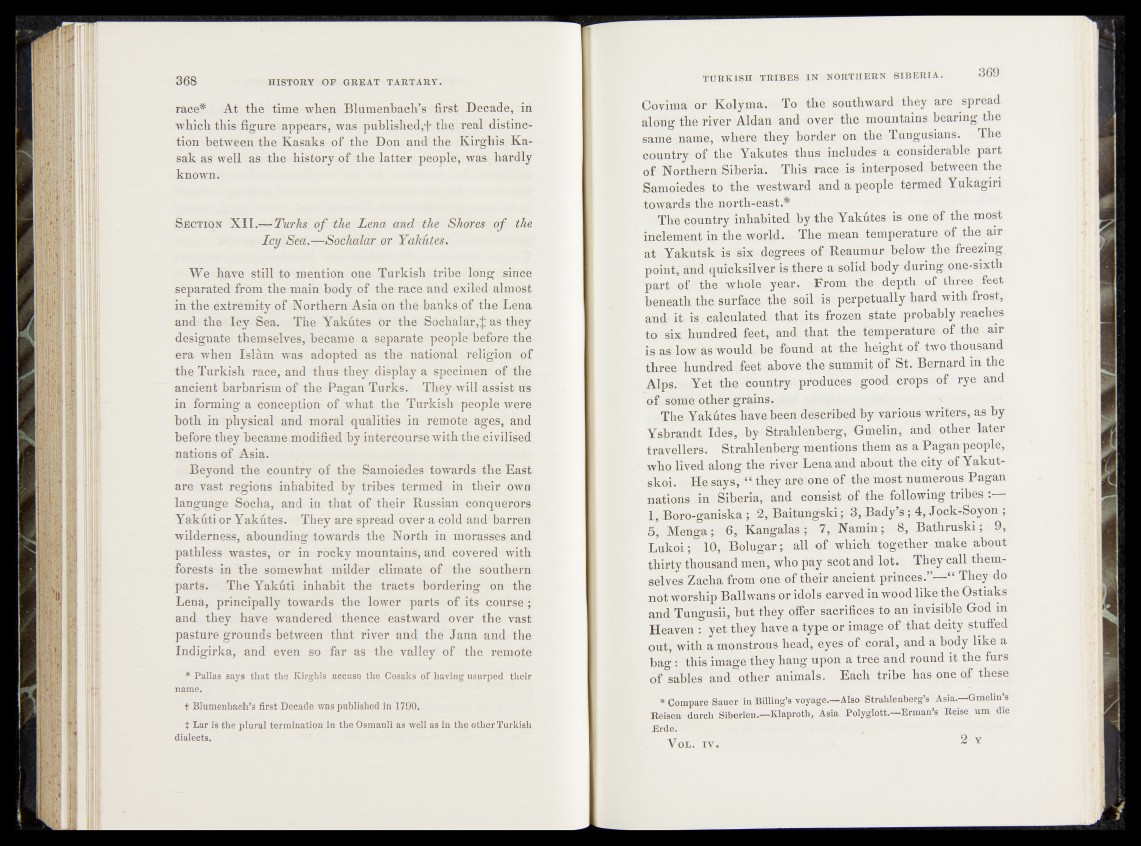
race* At the time when Blumenbach’s first Decade, in
which this figure appears, was published,“f* the real distinct
tion between the Kasaks of the Don and the Kirghis Ka-
sak as well as the history of the latter people, was hardly
known.
Section XII.—Turks of the Lena and the Shores of the
Icy Sea.—Sochalar or Yakutes.
We brave still to mention one Turkish tribe dong since
separated from the-main body of the race and exiled almost
in the extremity of Northern Asia on the banks óf :the Lena
and the- Icy Sea. The Yakütes or the Sochalar,J as-they
designate themselves, became a separate peöple’before the
era when Islam was adopted as the national religion of
the Turkish race, and thus they display a specimen of the
ancient barbarism of the Pagan Turks. They wilL assist us
in forming a conception of what the Turkish people werd
both in physical and moral qualities in remote ages, and-
before they became.modified by intercourse with the oiviliBed
nations of Asia.
Beyond the country of the Samoiedes towards the East
are vast regions inhabited by tribes termed in their own
language Soeha, and in that of their Russian conquerors
Yaküti or Yakütes. They are spread over a cold and'barren
wilderness, abounding towards the North in nxorasses and
pathless wastes, or in rocky mountains, and covered with
forests in the somewhat milder climate of the southern
parts. The Yaküti inhabit the tracts bordering oh the
Lena, principally towards the lower parts of its course;
and they have wandered thence eastward over the vast
pasture grounds between that river and the Jana and the
Indigirka, and even so far as the valley of the remote
* Pallas says that the Kirghis accuse the Cosaks óf having usurped their
name.
t Blumenbach’s first Decade was published in 1790.
. t Lar is the plural termination in the Osmanli as well as in the other Turkish
dialects.
Govima or Kolyma. To the southward they are spread
alôtig the river Aldan and over the mountains bearing the
same name, where /they border on the Tungusians. The
country, of/the, Yakutes,.thus includes a considerable part
of Northern Siberia. This race is interposed between the
Samoiedes to the, westward and a people termed Yukagiri
towards the north-east.*
The country inhabited, by the Yakutefcls one of the most
inclement in the world. The -mean temperature of the air
at Yakutsk is six .degrees :of Reaumur below the freezing,
point, and quicksilver is there asolid body during, one-sixth
'part ©f the who|e^year. From the depth of three feet
beneath the surface the soil is perpetually hard with frost,
and itds calculated that its frozen. stafeuprobably reaches
to six hundred feet, and that the; temperature , o£*the air
is asdow as would be found at the. hejgfet^f two thousand
three hundred-feet above the summit of, St. Bernard in the
Alps. Yet,the country produces good, crops of rye and
of someaother grains. ^ |
The Yakütes haverb'een described by various writers, as by
Ysbrandt Ides^by (Strahle.nberg, Gmelin, and other,dater
travellers. Strahlenberg mentions them as5 a Ragan people,
who lived alongithe river Lena and about thefo$ty?mf Yakut-
skoiv^ He says&tf. they arekme1 of the most, numerous Pagan
nations in Siberia, and consist of ? the .following tribes
1, Boro-ganiska ; 2, Baitungski ; 3, Bady^p4, Jock-Soyon ,
5, Menga; 6, Kangalas ; 7, Namin ; 8, Bathruski ; 9,
Lukoi; 10, Bolugar ; all of which-together make about
thirty thousand men, who payiscbt and, lot. They call themselves
Zacha from one of their ancient princes.’’—“ They do
not worship Ball wans or idols carved in wood like the Ostiaks
and Tungusii, but they offer;sacrifices to an invisible God in
Heaven : yet they have afltype,or image'of that deity stuffed
out, with a monstrous head, eyessdf^coràl, and a body like a
bag : this image they hang upon a tree and round it the furs
of sables and ot^er animal^ Bach tribe has. one of these,
* Compare Sauer in Billing’s voyage.—Also Strableaberg’s Asia,—GmelinV
Réisen durcb Siberien.rr-Klaproth, Asia Polyglott.—Erman’s Reise um die
Erde.
VOL. IV. T ^ Y